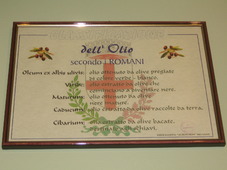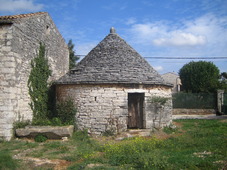to enlarge


or choose the place
from the menu below
 Rome |
 Byzantium |
 Venice |
 Vienna |
 Brioni |
 Smrikve |
 |
 |
The olive trees have a bit different story. The vineyard can live a century and the olive tree can live for millenniums. Thanks to this long life of the olive tree we do know that one of the sorts that were used during the Roman Empire time was the Istrian buza.
Today in Istria there are other sorts of olive trees but the olive oil is outstanding thanks to the geographic position of Istria. It is very hard to understand how Romans without sophisticated analysis instruments that do exist today were able to determine in which part of the Empire they were able to get the best food, olive oil and wine.
On Brioni island there is an olive tree from the beginning of the 4th century that is one of the oldest olive trees in Europe.
To give you an idea of his age just imagine that this olive tree was planted during the time of Emperor Costantine the Great.
Marcus Valerius Martialis, native from Cordoba, who lived in the 1st century AD, during the Roman Empire times, celebrated Istrian olive oil with the following verses: “Uncto Corduba Laetior Venafro Histra Nec Minus Absolute Testa”.
The translation would be: “Cordoba, you being more fertile than the olive oil region of Venafro and so perfect as the oil (amphora) from Istria”.
In Livio and Lorenzo’s Belci olive oil shop I leared from Mr. Livio Belci that Romans had five different olive oils quality ranking:
 Most of the old knowledge returned to Istria in the last decades thanks to the families
mentioned below and some other Istrian families that you will find in the olive oil section.
Most of the old knowledge returned to Istria in the last decades thanks to the families
mentioned below and some other Istrian families that you will find in the olive oil section.
The lavender again is another story. It is hard to prove what sort of lavender was grown in Istria at the time, and even if it was grown, but it is known that the lavender was needed in fullonica cleaning process.
Lavender lives much shortly than the vineyard so it is very easy that after the fall of the Roman civilisation we lost this production. With the fall of the Roman Empire the fullonica was not needed and neither the sweet smell for the Arena was needed.
 The last agricultural heritage we probably have in Istria from the Roman times are the
small circular ground-plan houses with roof of stone slates called “kazuni”.
The last agricultural heritage we probably have in Istria from the Roman times are the
small circular ground-plan houses with roof of stone slates called “kazuni”.
They remind the dry stone techniques of the old times, but actually this ground-plan houses can be found in Greece, in Provence in France, in Puglia in Italy are named trulli and can be found also in some other places in Europe like: Cataluna and Galicia in Spain, Abruzzo and Sardegna in Italy, and also in Irland and in Scotland.
I do believe that only the Roman civilisation was able to build such houses and in such quantities. There are so perfect that today a part from Branko Orbanic and few other people almost nobody can do it according to their original beauty.
Vodnjan area was one of the most important agricultural areas of the Roman Istria and was mainly used for the growing of the olive trees. Only around Vodnjan there are today over 2000 of this ground plan houses with roof of stones slates.
They are not spread all over Istria but only in parts that were mostly cultivated during the Roman Empire period.
Istrian olive oil as I wrote was one of the best in the Empire and there were several millions of olive trees in Istria. At the time this houses were needed by the workers for most different reasons: to hide from the sun and rain, to store the collected products and also to store the agricultural tools.